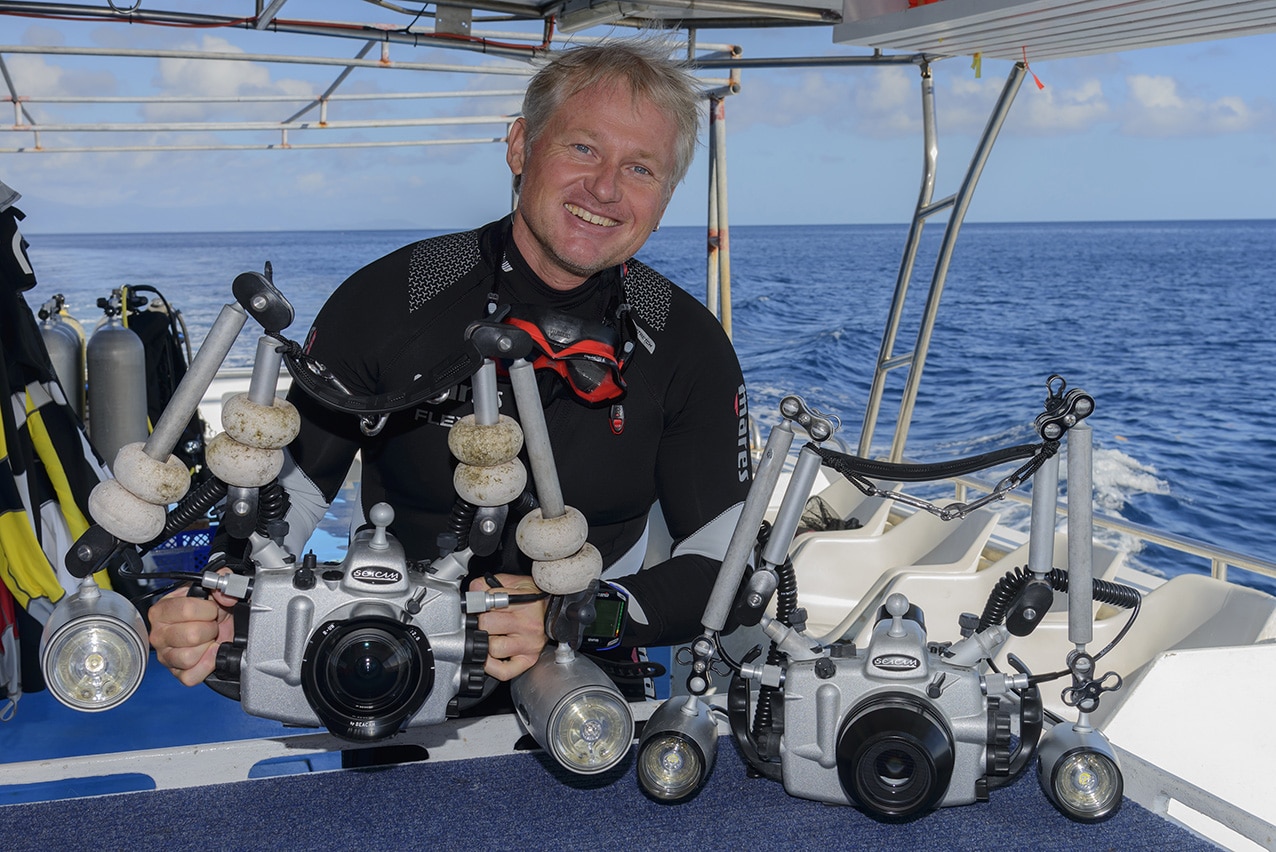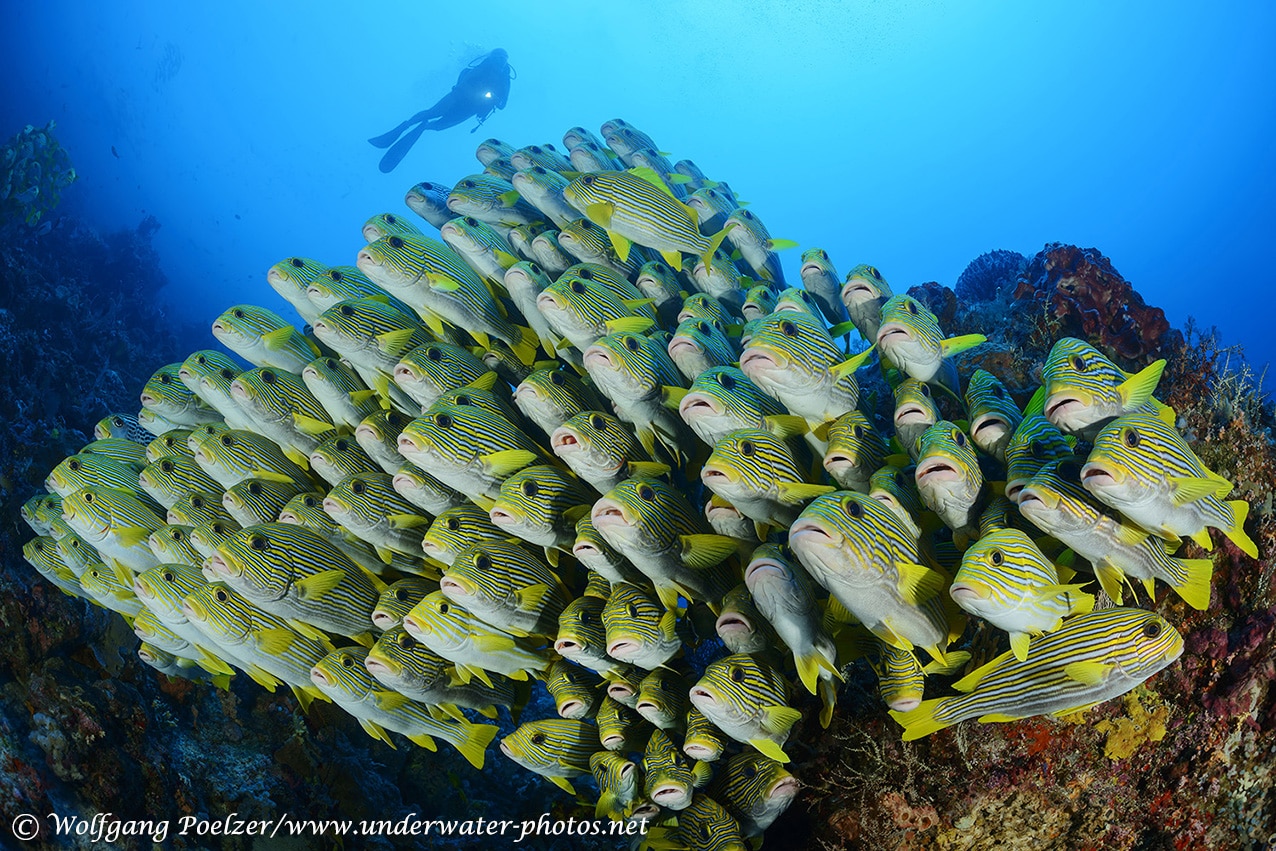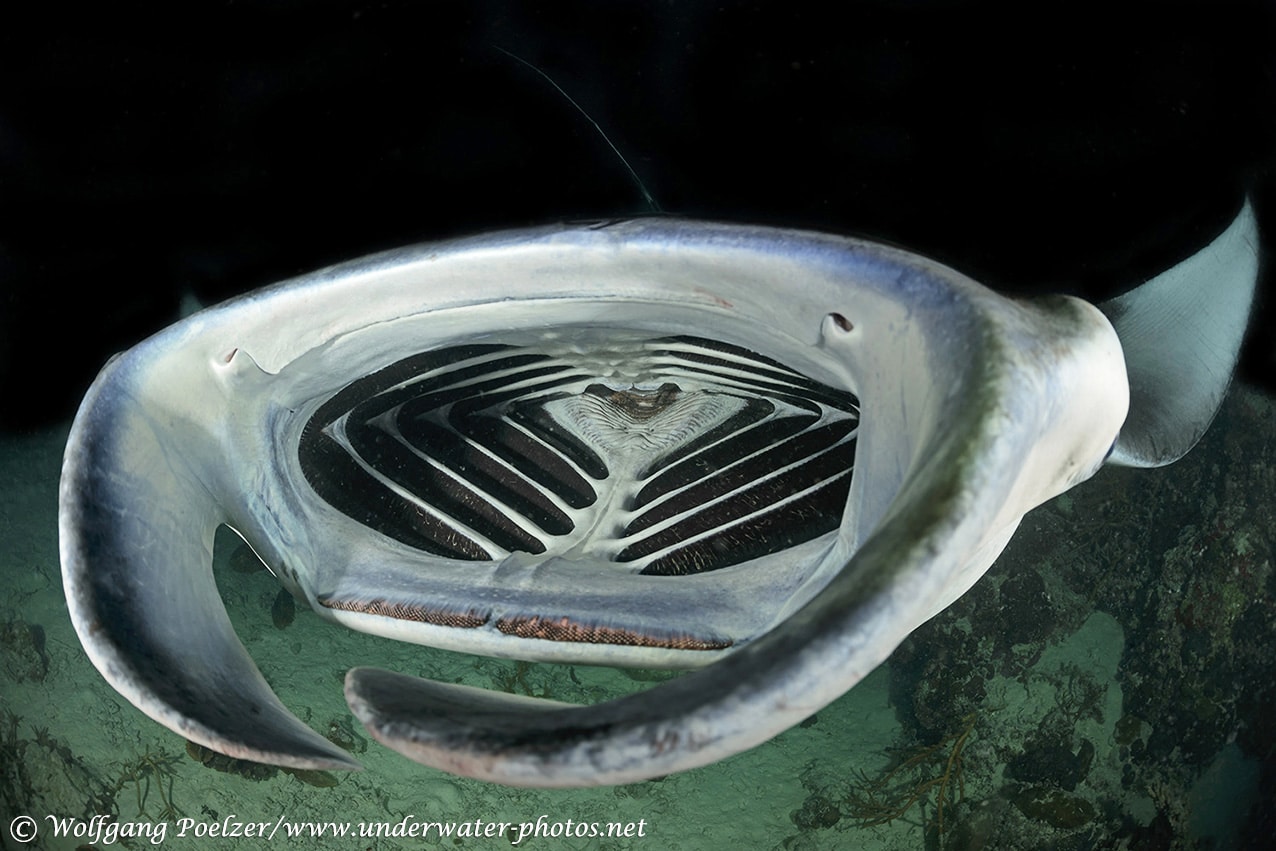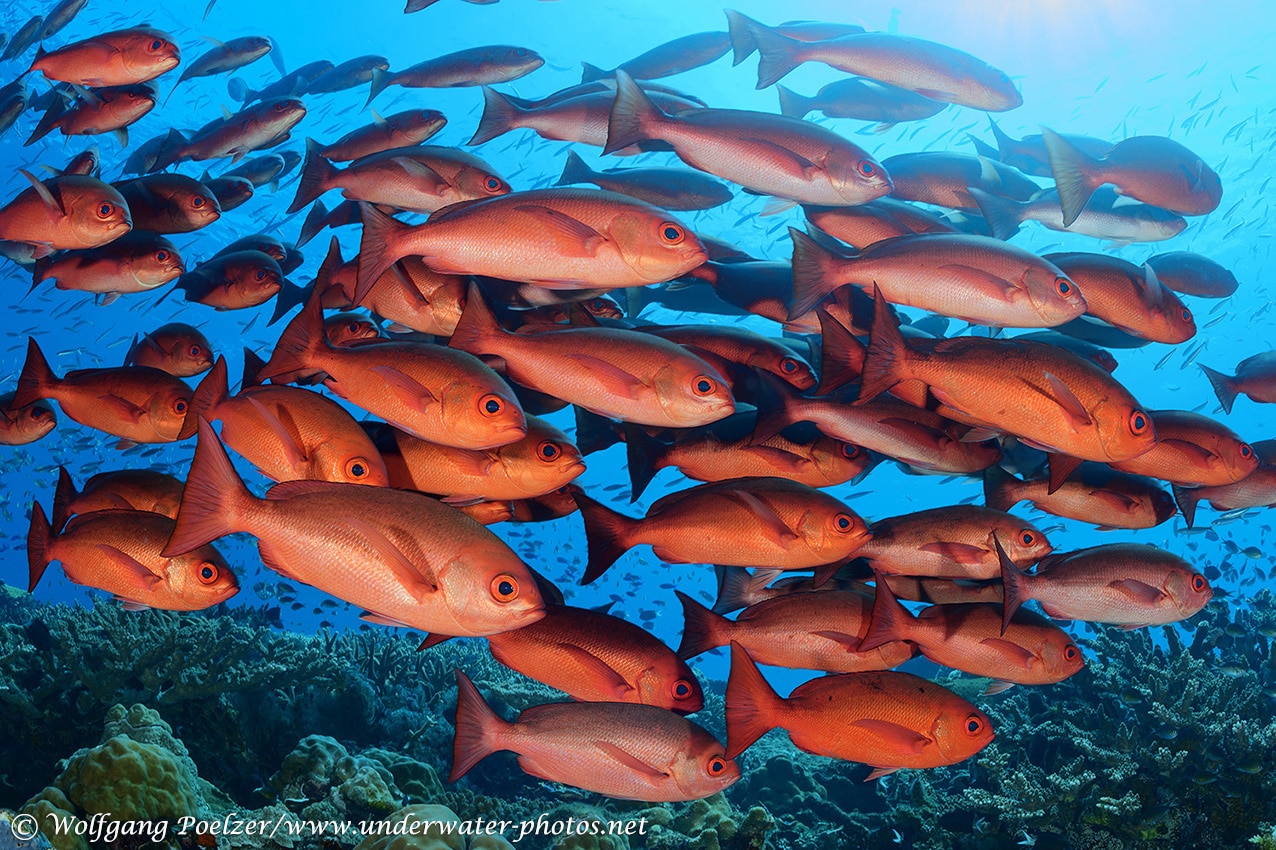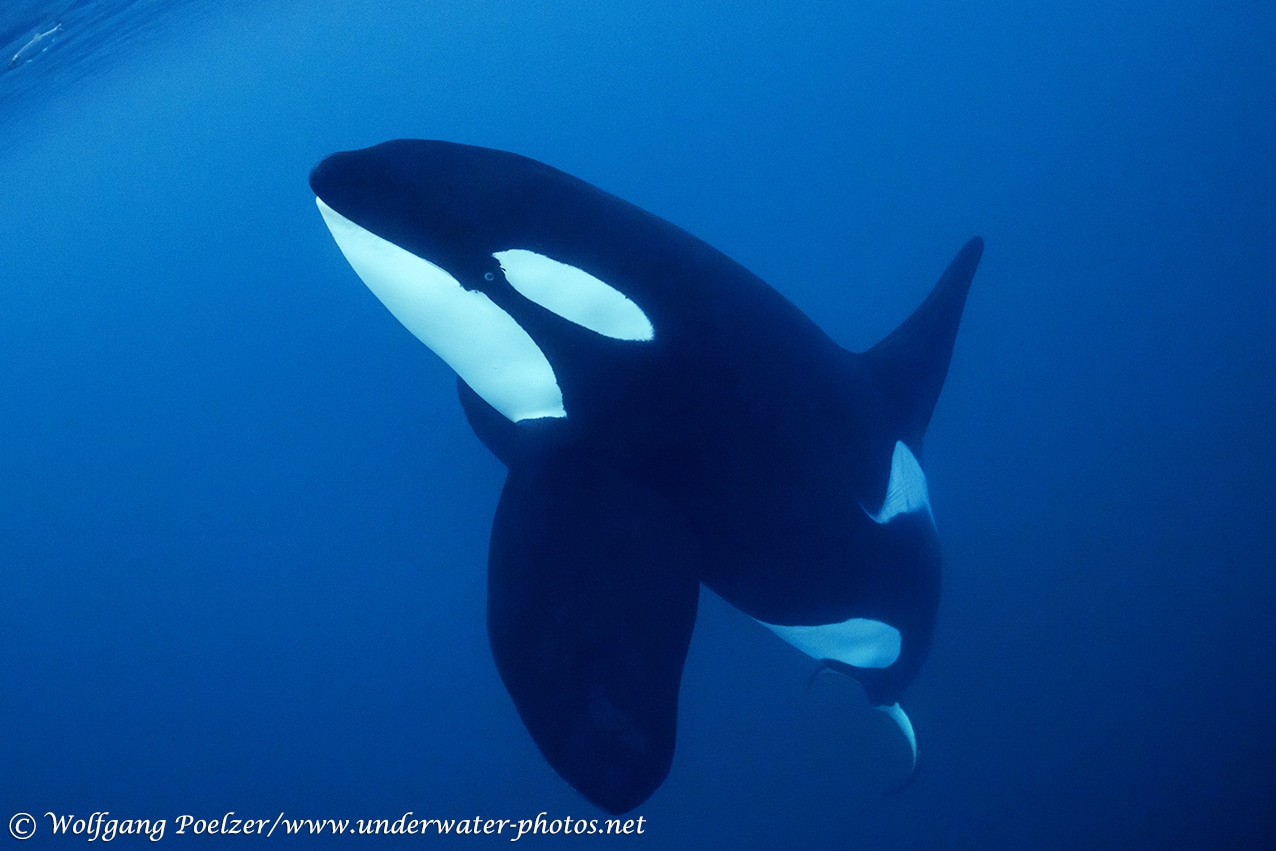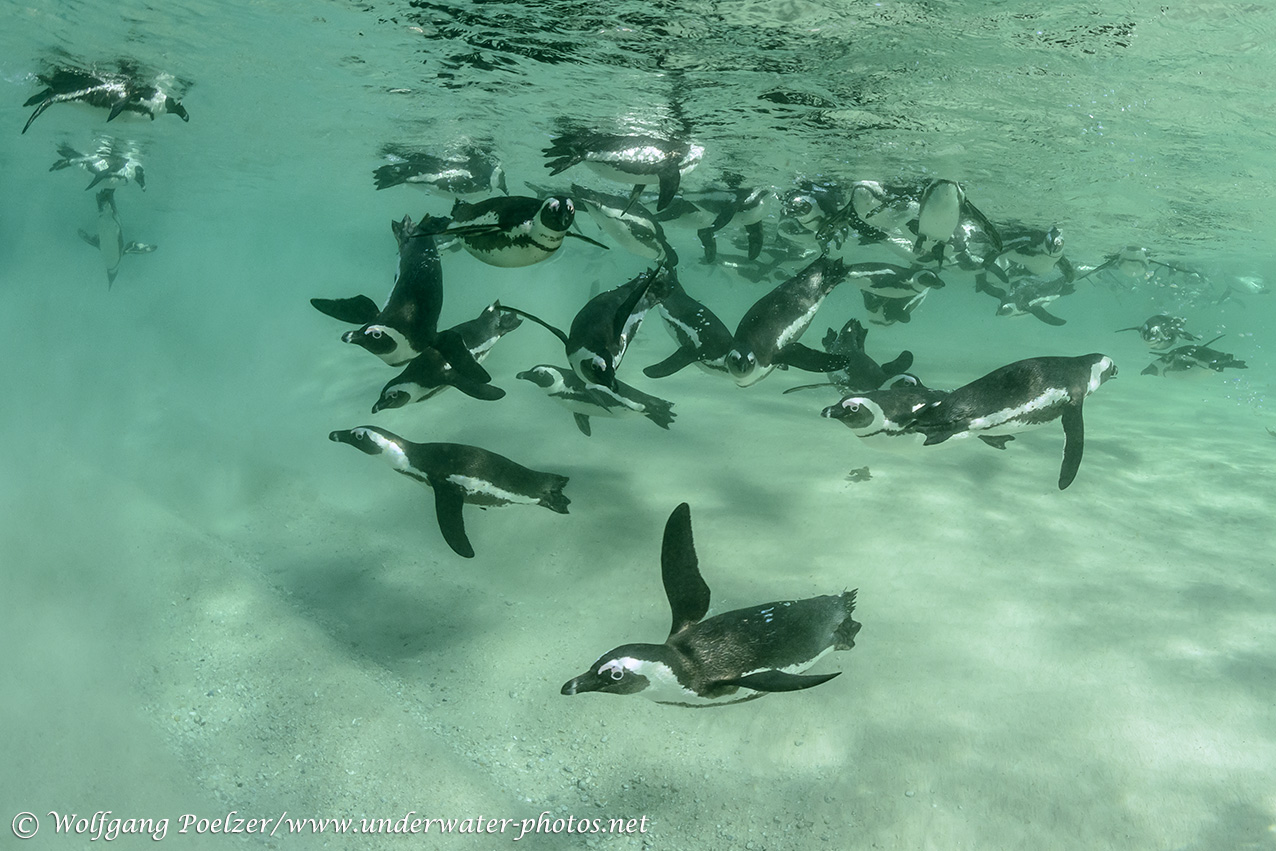Photo / Video News & Reviews
Scubaverse Underwater Photographer Interview: Wolfgang Poelzer
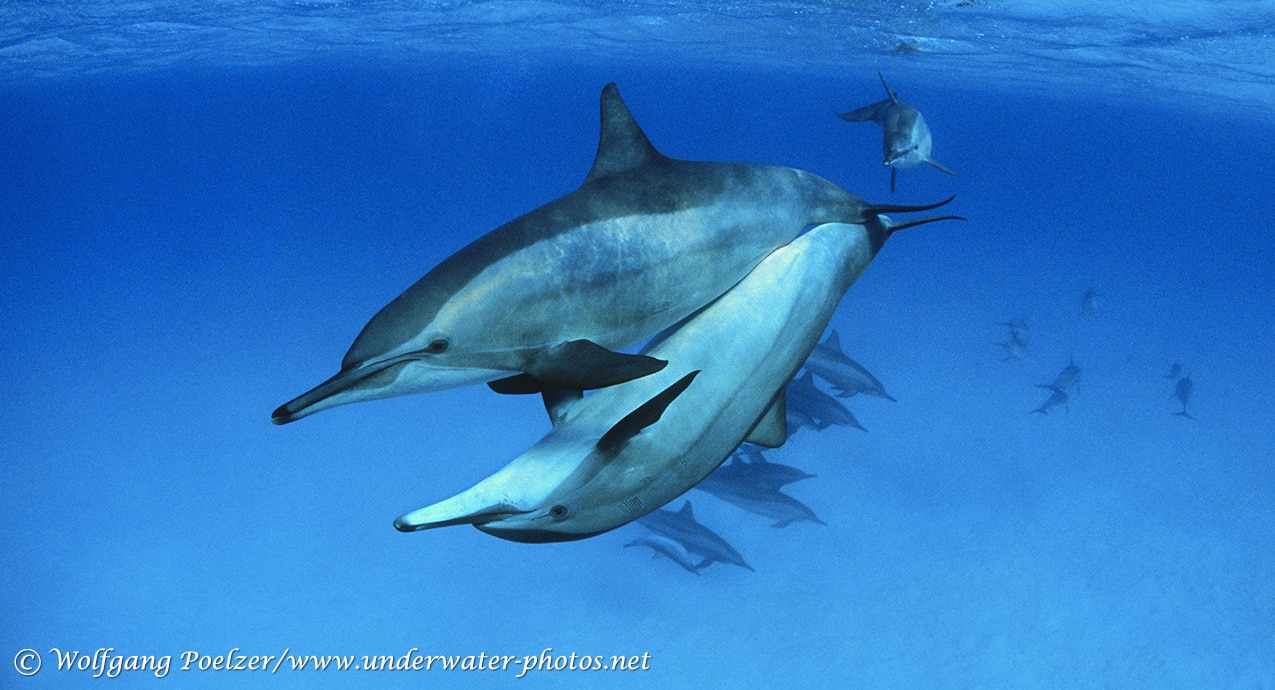
In an ongoing series, Scubaverse’s Underwater Photography Editor Nick Robertson-Brown talks to underwater photographers from around the world that he admires. In this blog: Wolfgang Poelzer
Wolfgang Poelzer is a well known Austrian full-time photojournalist and underwater photographer. He is a regular contributor to the leading German diving magazine TAUCHEN for more than 20 years, but his photos also gets published regularly in various media around the world. After getting a Master degree in Marine Biolgy he started taking photos under water seriously. Not to be forgotten at a time when digital photography was not yet invented and you had to limit yourself to 36 shots of a film during a dive. Among the numerous wins in photo competitions, two gold medals in the CMAS World Championships in underwater photography and one gold medal in the prestigious competition in Antibes deserve special mention. After he made underwater photography and journalism his profession, he no longer took part in photo competitions. If he is not travelling arround the world, he is taking pictures of babys swimming in the pool to please their parents. For many years Wolfgang Poelzer has also been an Ambassodor of MARES, the worldwide leader in the manufacturing and distribution of state-of-the-art diving equipment.
Instagram: @wolfgang_poelzer
Facebook: @wolfgang poelzer
NRB: How did your underwater photography start?
WP: Oh, it was back in the 90s of the last century when I borrowed a friend’s underwater camera just for fun. I bought the used camera including the Seacam underwater housing. That was a Minolta 7000 – the first SLR with autofocus! In the absence of a flash, my then girlfriend (and current wife) Barbara had to illuminate my motifs while taking pictures with her UW lamp. I quickly reached my limits with this equipment and first switched to the Nikonos system and soon after to a Nikon camera in the housing. Funnily enough, with one of my first photos with a fisheye lens in the housing, I won many awards at photo competitions. A landscape shot with my snorkeling wife in a crystal clear mountain lake in my home country Austria. A photo that participants tried to copy many years later when I was already on the jury at various competitions. One of my prizes in photo competitions was a trip to the Maldives, where I got in contact with the leading German diving magazine TAUCHEN, for which I soon wrote my first article. Only a few years later (1998) I became a professional and since then have been working as a travel journalist and underwater photographer.
NRB: What is your favourite u/w camera equipment (past & present) & why?
WP: Nikon D850 in a Seacam Housing with 2 Seacam Strobes. My favorite lens is the former 13 mm Fisheye lens from the Nikonos RS because it’s the best wide angle lens for underwater photography ever!
NRB: What would be your advice to anyone new to underwater photography?
WP: Learn to perfect your buoyancy skills first. Only when you feel completely at home under water, you can concentrate fully on photography and achieve good results.
NRB: What, or who, has been your single biggest inspiration for your underwater photography?
WP: After watching Hans Hass and Cousteau films in my childhood, I was mainly inspired by David Doubilet.
NRB: What image are you most proud of and why?
WP: A fishey photo of mating dolphins in the Red Sea (see top of page), just an arm’s length away from me! That was not only an extremely impressive feeling, it also led to a great result. That was in film times almost 20 years ago.
NRB: Where is your favourite dive location, and is it for the photography?
WP: My favorite diving region is Indonesia. 17,500 different islands offer a huge variety of great diving spots and are enough for much more than a whole diving life.
NRB: What are you views on marine life manipulation, moving subjects?
WP: I don’t want to be “more Catholic than the Pope”. Basically you shouldn’t touch or change anything under water! The least I like to see, if somebody takes a nudibranch and put on another surface, just to get a better photo. However, in my opinion it makes a difference, if you gently turn a sea cucumber to examine it for imperial shrimps or to tap a fan of gorgonians with a pointer to look for pygmy seahorses. The least to complain about environmentally friendly diving is anyone who photographs supermacro. Nobody can tell me that with 10 diopter lenses it is possible to take perfect sharp photos of tiny marine organisms while free floating in the water.
NRB: What do you look for when you are making your images?
WP: I am still looking for spots of beautiful, largely untouched nature on my dives. In order to show the beauty of nature in my photos even in times of pollution, marine acidification and extinction of species. If you only search and show the negative, many think that it is no longer worth protecting nature.
NRB: What motivates you to take u/w photos?
WP: I love the underwater world with all of its creatures or even “empty” landscapes. I can never stop trying to discover new things. And if nothing new, then at least familiar objects in a new light and a new perspective.
NRB: If you could photograph any one thing/place what or where would that be?
WP: There are still so many places, regions and countries left to visit – maybe Antarctica or New Zealand. Believe it or not, the Great White is still high on my bucket list, but also the bizarre-looking Leafy Seadragons from South Australia.
To see more of Wolfgang’s work click here.
Blogs
Diver Discovering Whale Skeletons Beneath Ice Judged World’s Best Underwater Photograph
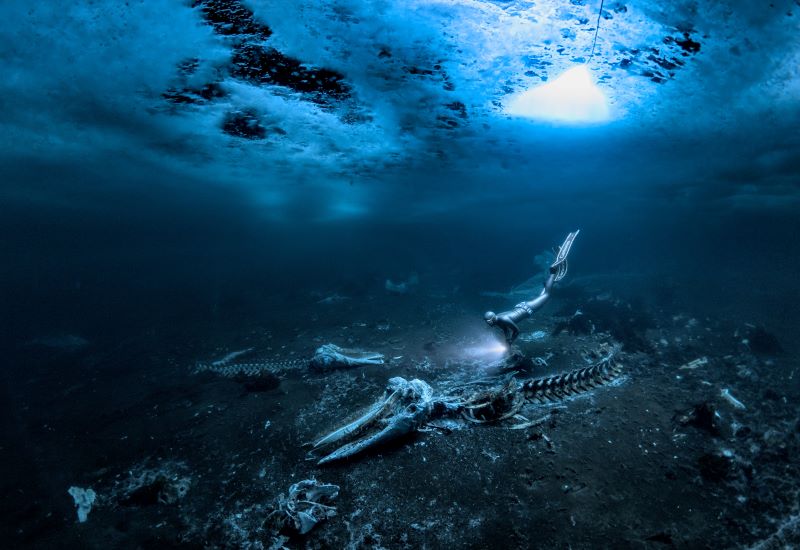
An emotive photograph showing a freediver examining the aftermath of whaling sees
Alex Dawson from Sweden named Underwater Photographer of the Year 2024. Dawson’s
photograph ‘Whale Bones’ triumphed over 6500 underwater pictures entered by underwater
photographers from around the world.
“Whale Bones was photographed in the toughest conditions,” explains chair of judging
panel Alex Mustard, “as a breath-hold diver descends below the Greenland ice sheet to bear
witness to the carcasses. The composition invites us to consider our impact on the great
creatures of this planet. Since the rise of humans, wild animals have declined by 85%. Today,
just 4% of mammals are wildlife, the remaining 96% are humans and our livestock. Our way
needs to change to find a balance with nature.”
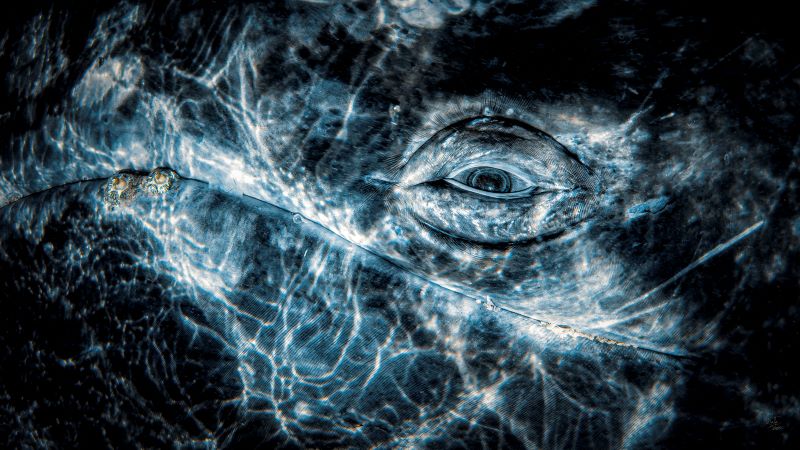
Photo: Rafael
Fernandez Caballero
Whales dominated the winning pictures this year with Spanish photographer Rafael
Fernandez Caballero winning two categories with his revealing photos of these ocean giants:
a close up of a grey whale’s eye and an action shot of a Bryde’s whale engulfing an entire bait
ball, both taken in Magdalena Bay, Baja California, Mexico. Fernandez Caballero took ‘Grey
Whale Connection’ while drifting in a small boat, holding his camera over the side in the water
to photograph the curious whale. ‘The End Of A Baitball’ required Fernandez Caballero to dive
down and be in exactly the right place at the moment the whale lunged. “The photo shows
the high speed attack,” he said, “with the whale engulfing hundreds of kilograms of sardines
in one bite — simply unforgettable to see predation on such a scale.”
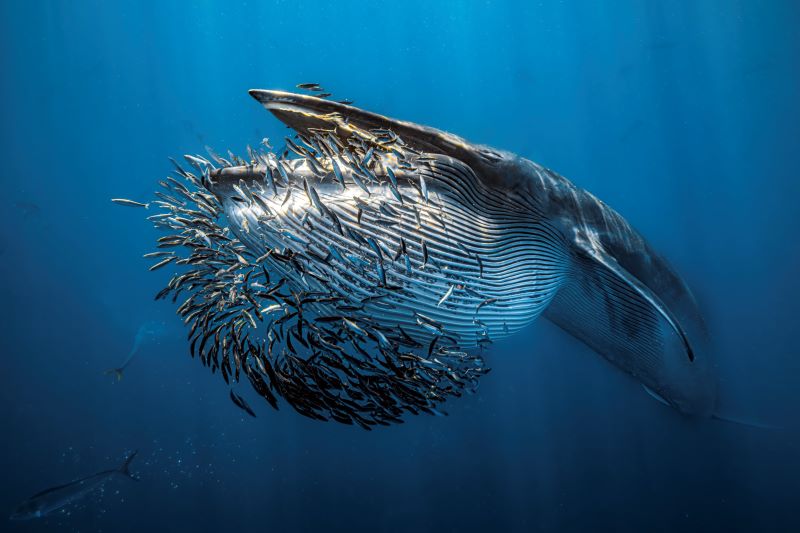
Photo: Rafael
Fernandez Caballero
Lisa Stengel from the United States was named Up & Coming Underwater Photographer of the Year 2024 for her image of a mahi-mahi catching a sardine, in Mexico. Stengel used both a very fast shutter speed and her hearing to catch the moment. “If you listen there’s an enormous amount of sound in the ocean,” she explained. “The action was too fast to see, so I honed in on the sound of the attacks with my camera to capture this special moment.”
“It is such an exciting time in underwater photography because photographers are capturing such amazing new images, by visiting new locations and using the latest cameras,”
commented judge Alex Mustard. “Until this year I’d hardly ever see a photo of a mahi mahi,
now Lisa has photographed one hunting, action that plays out in the blink of an eye.”
The Underwater Photographer of the Year contest is based in the UK, and Jenny Stock,
was named as British Underwater Photographer of the Year 2024 for her image “Star
Attraction”, which finds beauty in species of British wildlife that are often overlooked.
Exploring the west coast of Scotland, Stock explained “in the dark green depths my torch
picked out the vivid colours of a living carpet of thousands of brittle stars, each with a
different pattern. I was happily snapping away, when I spotted this purple sea urchin and I
got really excited.”
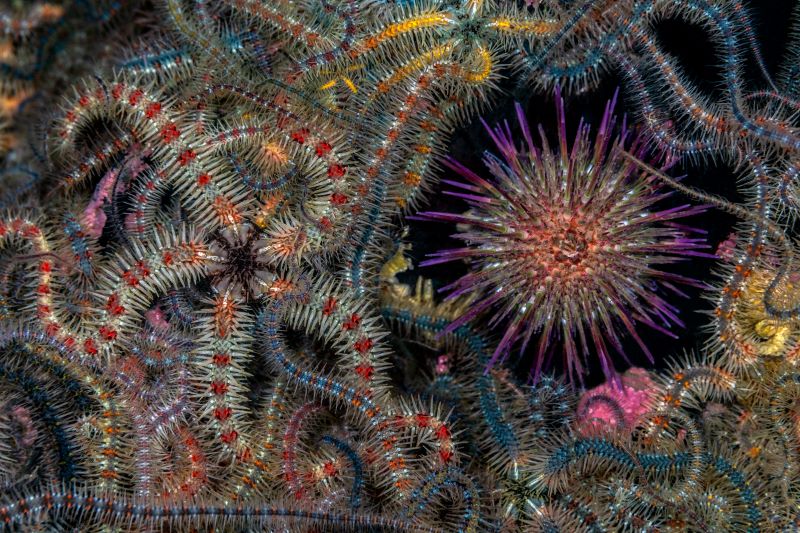
Photo: Jenny Stock
In the same contest, Portuguese photographer, Nuno Sá, was named ‘Save Our Seas
Foundation’ Marine Conservation Photographer of the Year 2024, with his photo ‘Saving
Goliath’, taken in Portugal. Sá’s photo shows beachgoers trying to save a stranded sperm
whale. The picture gives us hope that people do care and want to help the oceans, but also
warns us that bigger changes are needed. “The whale had been struck by a ship and its fate
was sealed,” explains Sá. “An estimated 20,000 whales are killed every year, and many more
injured, after being struck by ships-and few people even realise that it happens.”
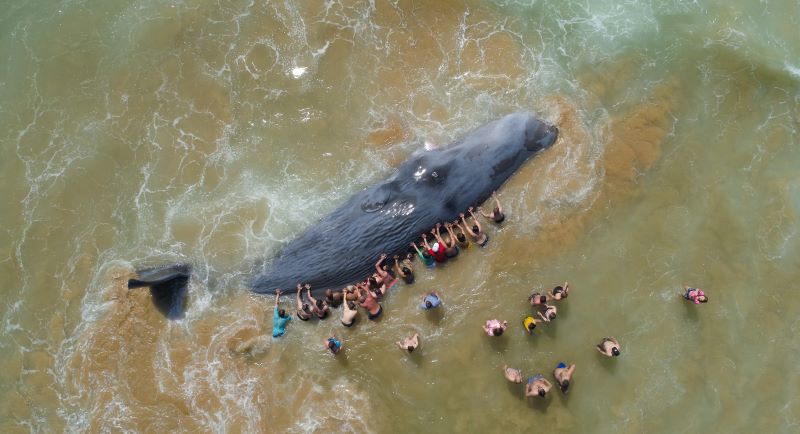
Photo: Nuno Sá
More winning images can be found at www.underwaterphotographeroftheyear.com.
About Underwater Photographer of the Year
Underwater Photographer of the Year is an annual competition, based in the UK, that celebrates photography beneath the surface of the ocean, lakes, rivers and even swimming pools, and attracts entries from all around the world. The contest has 13 categories, testing photographers with themes such as Macro, Wide Angle, Behaviour and Wreck photography, as well as four categories for photos taken specifically in British waters. The winners were announced in an award ceremony in Mayfair, London, hosted by The Crown Estate. This year’s UPY judges were experienced underwater photographers Peter Rowlands, Tobias Friedrich and Dr Alexander Mustard MBE.
Header image: Underwater Photographer of the Year 2024 winner Alex Dawson
News
World’s Best Underwater Photographers Unveil Breathtaking Images at World Shootout 2023
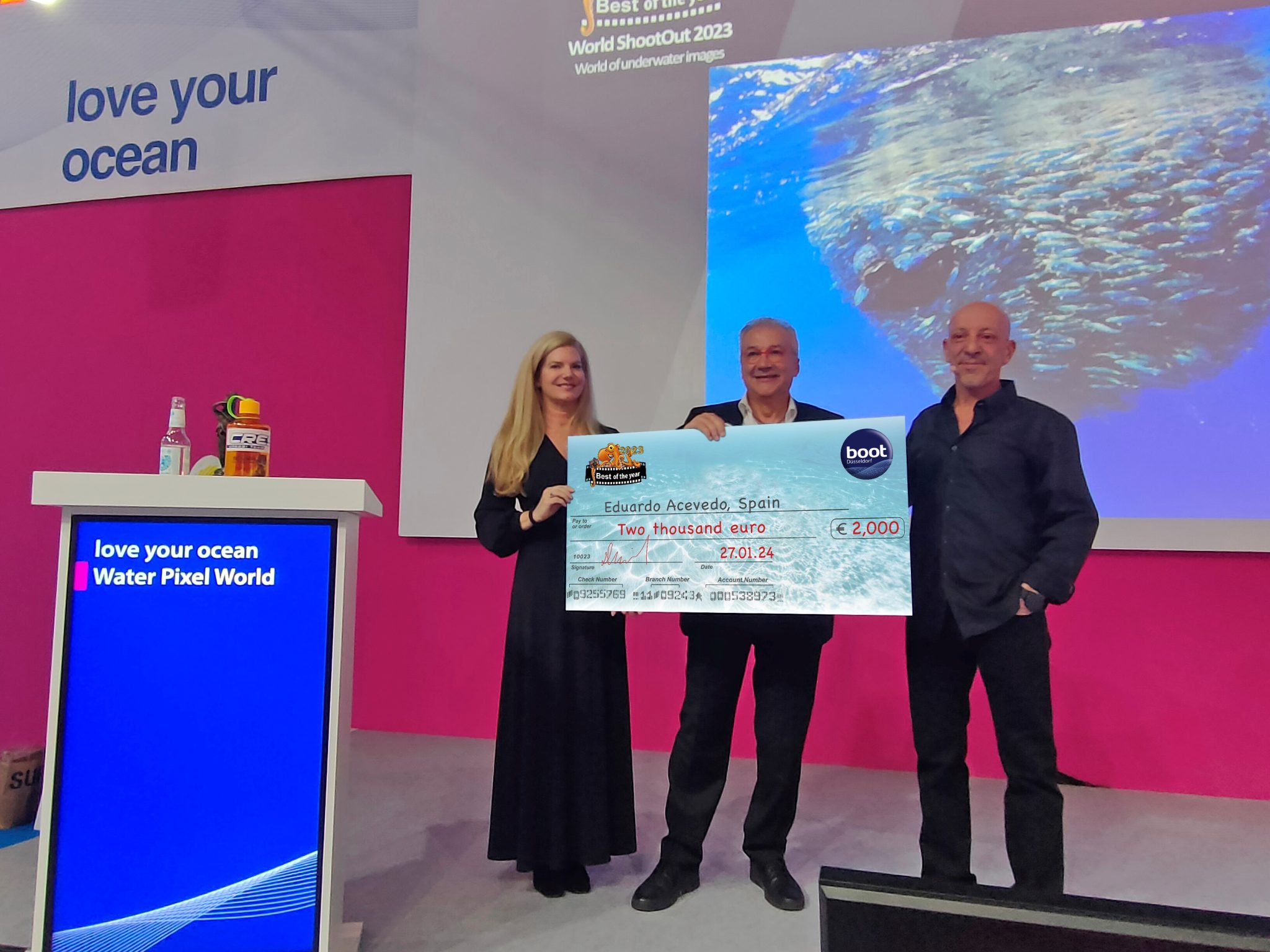
The winners of the prestigious World Shootout 2023 underwater photography competition were announced at this year’s BOOT Show, captivating audiences at the world’s largest diving and water sports exhibition in Dusseldorf, Germany. Hundreds of photographers from 54 countries competed across nine categories, pushing the boundaries of creativity and technical skill.
Grand Prize Winners
- Picture of the Year: Spanish photographer Eduardo Acevedo “secured” the top Honor with the prestigious prize the “boot Dusseldorf Director’s Prize, earning an Andromeda statuette and a €2,000 cash prize.
- Best 5 Images Portfolio: Luc Rooman from Belgium triumphed in this category, winning a dream 4-week diving trip for two to Papua New Guinea, valued at $18,900.
- Amateur Photographer: Alexandra Ceurvorst from the USA impressed the judges with her talent, taking home the 1,000 € cash prize award.
Celebrating Diversity and Innovation
This year’s competition saw 11,680 entries from 964 photographers, showcasing a remarkable spectrum of skills and perspectives. From the intricate wonders of Macro photography to the beauty of “Black Water”, the “Underwater Fashion” category added a touch of artistry and innovation, while the ever-important ” Environmental & Conservation” category served as a powerful reminder of the need to protect these fragile ecosystems.
Looking Ahead: AI and Ocean Conservation
World Shootout founder and producer David Pilosof unveiled an exciting addition for the 2024 competition: this year the Environmental category will be focusing on the impact of plastic on our oceans and future.
This category will embrace the potential of AI or other editing software as a tool to amplify the conservation message.
Entrants will submit campaigns of three original underwater photographs dealing with plastic pollution, along with their final AI assistance processing. This innovative approach encourages artistic expression while raising awareness about a critical environmental issue.
Explore the Stunning Collection
Discover the complete album of competition entries by clicking here.
For Low-resolution photos of finalist entries in eight categories, click here.
-

 News3 months ago
News3 months agoHone your underwater photography skills with Alphamarine Photography at Red Sea Diving Safari in March
-

 News3 months ago
News3 months agoCapturing Critters in Lembeh Underwater Photography Workshop 2024: Event Roundup
-

 Marine Life & Conservation Blogs3 months ago
Marine Life & Conservation Blogs3 months agoCreature Feature: Swell Sharks
-

 Blogs2 months ago
Blogs2 months agoMurex Resorts: Passport to Paradise!
-

 Blogs2 months ago
Blogs2 months agoDiver Discovering Whale Skeletons Beneath Ice Judged World’s Best Underwater Photograph
-

 Marine Life & Conservation2 months ago
Marine Life & Conservation2 months agoSave the Manatee Club launches brand new webcams at Silver Springs State Park, Florida
-

 Gear Reviews3 months ago
Gear Reviews3 months agoGear Review: Oceanic+ Dive Housing for iPhone
-

 Gear Reviews2 weeks ago
Gear Reviews2 weeks agoGEAR REVIEW – Revolutionising Diving Comfort: The Sharkskin T2 Chillproof Suit


